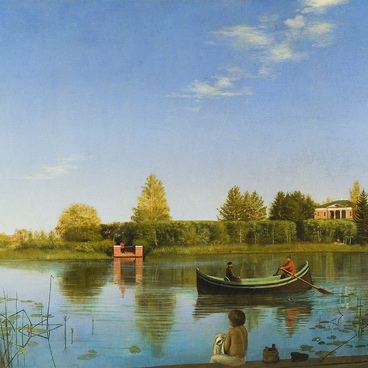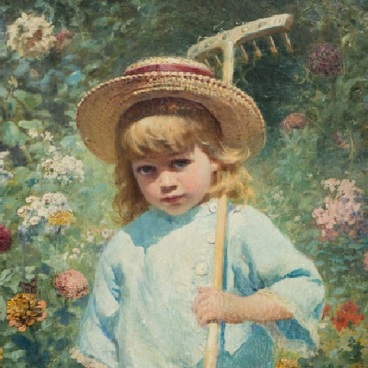‘Death of Prince Mikhail of Tver’ was painted by Ivan Orlov. There’s not much information left about the artist. He was born in the village Nesterovo in Staritsky region and worked as a local painter. Two works for the Transfiguration Cathedral telling about the last days of Prince Mikhail Yaroslavich’s life were commissioned to him. One of them was painted in 1847.
The cathedral was built during Mikhail of Tver’s princedom in 1285-1290. It was a significant event as it was the first cathedral made of white stone and built after the Tatar-Mongol yoke. The Transfiguration Cathedral in Tver served as a burial vault for Tver’s princes and bishops and was a symbol of the union and independence of the Tver princedom. The cathedral was reconstructed in the end of the 17th century, and by the end of the 19th century was one of the biggest Russian cathedrals with iconostasis made by Tver’s artists in the 17th century. Moreover, it contained precious religious utensils and artworks. Ivan Orlov’s paintings were later added to this great collection.
These paintings were commissioned by merchant Sutugin for the cathedral’s decoration during the time of Tver’s bishop Grigory Postnikov. The paintings were placed at the columns in front of the altar. They became so famous that later on they were used as illustrations for Mikhail of Tver’s biography in 1864 arranged by Alexander Sokolov, the priest of Tver Cathedral church in 1864. Mikhail of Tver was canonized for his martyr’s death in the Golden Horde which he met for the reason of the Moscow Prince’s Yury Danilovich’s false accusation because of his wife’s death at Tver’s captivity.
In his depiction of Mikhail of Tver’s execution, Ivan Orlov followed the academic art traditions. The artist refrains from the everyday details, neglects the ordinary sphere in order to underline the event’s drama. We see that, while the Mikhail’s murderers are ready to deliver a death blow, the prince himself is kind of distracted from that moment. He’s looking at the sky, and an angel descending from the Heaven is about to open the Kingdom of God to him. His static position, in fact the only one among other dynamic images behind the prince’s back, helps to give the impression of detachment. The painting itself represents the symbol of the Russian spirit and the true human greatness. The artist glorified the outstanding and heroic prince’s deed in the splendid narrative manner according to all laws of the academic painting of mid-19th century.
This painting’s destiny was more fortunate than the one of the Transfiguration Cathedral. In 1935 the “League of Militant Atheists” functioned in Kalinin. The cathedral was imploded, the saint prince’s relics didn’t survive, and the paintings transferred to the museum required restoration. Recently the historical injustice was redressed by the senior researcher of the museum Nata Mayorova: for a long time this work was attributed to the artist Pimen Orlov, who worked at the same epoch with Ivan Orlov.
The cathedral was built during Mikhail of Tver’s princedom in 1285-1290. It was a significant event as it was the first cathedral made of white stone and built after the Tatar-Mongol yoke. The Transfiguration Cathedral in Tver served as a burial vault for Tver’s princes and bishops and was a symbol of the union and independence of the Tver princedom. The cathedral was reconstructed in the end of the 17th century, and by the end of the 19th century was one of the biggest Russian cathedrals with iconostasis made by Tver’s artists in the 17th century. Moreover, it contained precious religious utensils and artworks. Ivan Orlov’s paintings were later added to this great collection.
These paintings were commissioned by merchant Sutugin for the cathedral’s decoration during the time of Tver’s bishop Grigory Postnikov. The paintings were placed at the columns in front of the altar. They became so famous that later on they were used as illustrations for Mikhail of Tver’s biography in 1864 arranged by Alexander Sokolov, the priest of Tver Cathedral church in 1864. Mikhail of Tver was canonized for his martyr’s death in the Golden Horde which he met for the reason of the Moscow Prince’s Yury Danilovich’s false accusation because of his wife’s death at Tver’s captivity.
In his depiction of Mikhail of Tver’s execution, Ivan Orlov followed the academic art traditions. The artist refrains from the everyday details, neglects the ordinary sphere in order to underline the event’s drama. We see that, while the Mikhail’s murderers are ready to deliver a death blow, the prince himself is kind of distracted from that moment. He’s looking at the sky, and an angel descending from the Heaven is about to open the Kingdom of God to him. His static position, in fact the only one among other dynamic images behind the prince’s back, helps to give the impression of detachment. The painting itself represents the symbol of the Russian spirit and the true human greatness. The artist glorified the outstanding and heroic prince’s deed in the splendid narrative manner according to all laws of the academic painting of mid-19th century.
This painting’s destiny was more fortunate than the one of the Transfiguration Cathedral. In 1935 the “League of Militant Atheists” functioned in Kalinin. The cathedral was imploded, the saint prince’s relics didn’t survive, and the paintings transferred to the museum required restoration. Recently the historical injustice was redressed by the senior researcher of the museum Nata Mayorova: for a long time this work was attributed to the artist Pimen Orlov, who worked at the same epoch with Ivan Orlov.



